| Listing 1 - 9 of 9 |
Sort by
|
Book
ISBN: 3110780917 Year: 2022 Publisher: Berlin ; Boston : Walter de Gruyter GmbH,
Abstract | Keywords | Export | Availability | Bookmark
 Loading...
Loading...Choose an application
- Reference Manager
- EndNote
- RefWorks (Direct export to RefWorks)
The term “stereotype space” was introduced in 1995 and denotes a category of locally convex spaces with surprisingly elegant properties. Its study gives an unexpected point of view on functional analysis that brings this fi eld closer to other main branches of mathematics, namely, to algebra and geometry. This volume contains the foundations of the theory of stereotype spaces, with accurate definitions, formulations, proofs, and numerous examples illustrating the interaction of this discipline with the category theory, the theory of Hopf algebras, and the four big geometric disciplines: topology, differential geometry, complex geometry, and algebraic geometry.
Book
ISBN: 3038973254 3038973246 Year: 2019 Publisher: MDPI - Multidisciplinary Digital Publishing Institute
Abstract | Keywords | Export | Availability | Bookmark
 Loading...
Loading...Choose an application
- Reference Manager
- EndNote
- RefWorks (Direct export to RefWorks)
The Yang-Baxter equation first appeared in theoretical physics, in a paper by the Nobel laureate C.N. Yang and in the work of R.J. Baxter in the field of Statistical Mechanics. At the 1990 International Mathematics Congress, Vladimir Drinfeld, Vaughan F. R. Jones, and Edward Witten were awarded Fields Medals for their work related to the Yang-Baxter equation. It turned out that this equation is one of the basic equations in mathematical physics; more precisely, it is used for introducing the theory of quantum groups. It also plays a crucial role in: knot theory, braided categories, the analysis of integrable systems, non-commutative descent theory, quantum computing, non-commutative geometry, etc. Many scientists have used the axioms of various algebraic structures (quasi-triangular Hopf algebras, Yetter-Drinfeld categories, quandles, group actions, Lie (super)algebras, brace structures, (co)algebra structures, Jordan triples, Boolean algebras, relations on sets, etc.) or computer calculations (and Grobner bases) in order to produce solutions for the Yang-Baxter equation. However, the full classification of its solutions remains an open problem. At present, the study of solutions of the Yang-Baxter equation attracts the attention of a broad circle of scientists. The current volume highlights various aspects of the Yang-Baxter equation, related algebraic structures, and applications.
braided category --- quasitriangular structure --- quantum projective space --- Hopf algebra --- quantum integrability --- duality --- six-vertex model --- Quantum Group --- Yang-Baxter equation --- star-triangle relation --- R-matrix --- Lie algebra --- bundle --- braid group
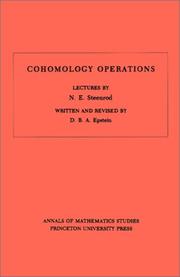
ISBN: 0691079242 1400881676 Year: 2016 Publisher: Princeton, NJ : Princeton University Press,
Abstract | Keywords | Export | Availability | Bookmark
 Loading...
Loading...Choose an application
- Reference Manager
- EndNote
- RefWorks (Direct export to RefWorks)
Written and revised by D. B. A. Epstein.
Category theory. Homological algebra --- 515.14 --- Algebraic topology --- Homology theory. --- 515.14 Algebraic topology --- Cohomology theory --- Contrahomology theory --- Algebra homomorphism. --- Algebra over a field. --- Algebraic structure. --- Approximation. --- Axiom. --- Basis (linear algebra). --- CW complex. --- Cartesian product. --- Classical group. --- Coefficient. --- Cohomology operation. --- Cohomology ring. --- Cohomology. --- Commutative property. --- Complex number. --- Computation. --- Continuous function. --- Cup product. --- Cyclic group. --- Diagram (category theory). --- Dimension. --- Direct limit. --- Embedding. --- Existence theorem. --- Fibration. --- Homomorphism. --- Hopf algebra. --- Hopf invariant. --- Ideal (ring theory). --- Integer. --- Inverse limit. --- Manifold. --- Mathematics. --- Monomial. --- N-skeleton. --- Natural transformation. --- Permutation. --- Quaternion. --- Ring (mathematics). --- Scalar (physics). --- Special unitary group. --- Steenrod algebra. --- Stiefel manifold. --- Subgroup. --- Subset. --- Summation. --- Symmetric group. --- Symplectic group. --- Theorem. --- Uniqueness theorem. --- Upper and lower bounds. --- Vector field. --- Vector space. --- W0.
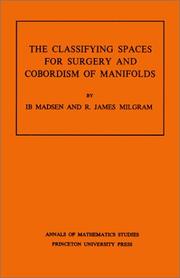
ISBN: 0691082251 069108226X 1400881471 Year: 1979 Publisher: Princeton : Tokyo : Princeton University Press Tokyo university press,
Abstract | Keywords | Export | Availability | Bookmark
 Loading...
Loading...Choose an application
- Reference Manager
- EndNote
- RefWorks (Direct export to RefWorks)
Beginning with a general discussion of bordism, Professors Madsen and Milgram present the homotopy theory of the surgery classifying spaces and the classifying spaces for the various required bundle theories. The next part covers more recent work on the maps between these spaces and the properties of the PL and Top characteristic classes, and includes integrality theorems for topological and PL manifolds. Later chapters treat the integral cohomology of BPL and Btop. The authors conclude with a discussion of the PL and topological cobordism rings and a construction of the torsion-free generators.
Algebraic topology --- 515.16 --- Classifying spaces --- Cobordism theory --- Manifolds (Mathematics) --- Surgery (Topology) --- Differential topology --- Homotopy equivalences --- Topology --- Geometry, Differential --- Spaces, Classifying --- Fiber bundles (Mathematics) --- Fiber spaces (Mathematics) --- Topology of manifolds --- Classifying spaces. --- Cobordism theory. --- Manifolds (Mathematics). --- Surgery (Topology). --- 515.16 Topology of manifolds --- Bijection. --- Calculation. --- Characteristic class. --- Classification theorem. --- Classifying space. --- Closed manifold. --- Cobordism. --- Coefficient. --- Cohomology. --- Commutative diagram. --- Commutative property. --- Complex projective space. --- Connected sum. --- Corollary. --- Cup product. --- Diagram (category theory). --- Differentiable manifold. --- Disjoint union. --- Disk (mathematics). --- Effective method. --- Eilenberg–Moore spectral sequence. --- Elaboration. --- Equivalence class. --- Exact sequence. --- Exterior algebra. --- Fiber bundle. --- Fibration. --- Function composition. --- H-space. --- Homeomorphism. --- Homomorphism. --- Homotopy fiber. --- Homotopy group. --- Homotopy. --- Hopf algebra. --- Iterative method. --- Loop space. --- Manifold. --- Massey product. --- N-sphere. --- Normal bundle. --- Obstruction theory. --- Pairing. --- Permutation. --- Piecewise linear manifold. --- Piecewise linear. --- Polynomial. --- Prime number. --- Projective space. --- Sequence. --- Simply connected space. --- Special case. --- Spin structure. --- Steenrod algebra. --- Subset. --- Summation. --- Tensor product. --- Theorem. --- Topological group. --- Topological manifold. --- Topology. --- Total order. --- Variétés topologiques --- Topologie differentielle
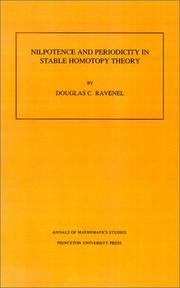
ISBN: 069108792X 069102572X 1400882486 9780691025728 9780691087924 Year: 2016 Volume: 128 Publisher: Princeton, NJ : Princeton University Press,
Abstract | Keywords | Export | Availability | Bookmark
 Loading...
Loading...Choose an application
- Reference Manager
- EndNote
- RefWorks (Direct export to RefWorks)
Nilpotence and Periodicity in Stable Homotopy Theory describes some major advances made in algebraic topology in recent years, centering on the nilpotence and periodicity theorems, which were conjectured by the author in 1977 and proved by Devinatz, Hopkins, and Smith in 1985. During the last ten years a number of significant advances have been made in homotopy theory, and this book fills a real need for an up-to-date text on that topic. Ravenel's first few chapters are written with a general mathematical audience in mind. They survey both the ideas that lead up to the theorems and their applications to homotopy theory. The book begins with some elementary concepts of homotopy theory that are needed to state the problem. This includes such notions as homotopy, homotopy equivalence, CW-complex, and suspension. Next the machinery of complex cobordism, Morava K-theory, and formal group laws in characteristic p are introduced. The latter portion of the book provides specialists with a coherent and rigorous account of the proofs. It includes hitherto unpublished material on the smash product and chromatic convergence theorems and on modular representations of the symmetric group.
Homotopie --- Homotopy theory --- Homotopy theory. --- Deformations, Continuous --- Topology --- Abelian category. --- Abelian group. --- Adams spectral sequence. --- Additive category. --- Affine space. --- Algebra homomorphism. --- Algebraic closure. --- Algebraic structure. --- Algebraic topology (object). --- Algebraic topology. --- Algebraic variety. --- Algebraically closed field. --- Atiyah–Hirzebruch spectral sequence. --- Automorphism. --- Boolean algebra (structure). --- CW complex. --- Canonical map. --- Cantor set. --- Category of topological spaces. --- Category theory. --- Classification theorem. --- Classifying space. --- Cohomology operation. --- Cohomology. --- Cokernel. --- Commutative algebra. --- Commutative ring. --- Complex projective space. --- Complex vector bundle. --- Computation. --- Conjecture. --- Conjugacy class. --- Continuous function. --- Contractible space. --- Coproduct. --- Differentiable manifold. --- Disjoint union. --- Division algebra. --- Equation. --- Explicit formulae (L-function). --- Functor. --- G-module. --- Groupoid. --- Homology (mathematics). --- Homomorphism. --- Homotopy category. --- Homotopy group. --- Homotopy. --- Hopf algebra. --- Hurewicz theorem. --- Inclusion map. --- Infinite product. --- Integer. --- Inverse limit. --- Irreducible representation. --- Isomorphism class. --- K-theory. --- Loop space. --- Mapping cone (homological algebra). --- Mathematical induction. --- Modular representation theory. --- Module (mathematics). --- Monomorphism. --- Moore space. --- Morava K-theory. --- Morphism. --- N-sphere. --- Noetherian ring. --- Noetherian. --- Noncommutative ring. --- Number theory. --- P-adic number. --- Piecewise linear manifold. --- Polynomial ring. --- Polynomial. --- Power series. --- Prime number. --- Principal ideal domain. --- Profinite group. --- Reduced homology. --- Ring (mathematics). --- Ring homomorphism. --- Ring spectrum. --- Simplicial complex. --- Simply connected space. --- Smash product. --- Special case. --- Spectral sequence. --- Steenrod algebra. --- Sub"ient. --- Subalgebra. --- Subcategory. --- Subring. --- Symmetric group. --- Tensor product. --- Theorem. --- Topological space. --- Topology. --- Vector bundle. --- Zariski topology.
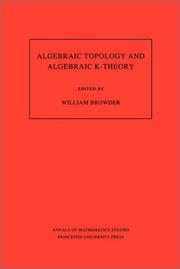
ISBN: 0691084157 0691084262 1400882117 Year: 1987 Publisher: Princeton : Princeton University Press,
Abstract | Keywords | Export | Availability | Bookmark
 Loading...
Loading...Choose an application
- Reference Manager
- EndNote
- RefWorks (Direct export to RefWorks)
This book contains accounts of talks held at a symposium in honorof John C. Moore in October 1983 at Princeton University, The workincludes papers in classical homotopy theory, homological algebra,rational homotopy theory, algebraic K-theory of spaces, and othersubjects.
Algebraic topology --- K-theory --- 512.73 --- 515.14 --- 512.73 Cohomology theory of algebraic varieties and schemes --- Cohomology theory of algebraic varieties and schemes --- 515.14 Algebraic topology --- Moore, John C. --- Abelian group. --- Adams spectral sequence. --- Adjoint functors. --- Adjunction (field theory). --- Algebraic K-theory. --- Algebraic closure. --- Algebraic geometry. --- Algebraic group. --- Algebraic number field. --- Algebraic space. --- Algebraic topology. --- Algebraically closed field. --- Associative algebra. --- Boundary (topology). --- CW complex. --- Classification theorem. --- Closure (mathematics). --- Coalgebra. --- Cofibration. --- Cohomology. --- Commutative diagram. --- Commutative property. --- Coproduct. --- Deformation theory. --- Degenerate bilinear form. --- Diagram (category theory). --- Differentiable manifold. --- Dimension (vector space). --- Division algebra. --- Eilenberg–Moore spectral sequence. --- Epimorphism. --- Exterior (topology). --- Formal power series. --- Free Lie algebra. --- Free algebra. --- Freudenthal suspension theorem. --- Function (mathematics). --- Function space. --- Functor. --- G-module. --- Galois extension. --- Global dimension. --- Group cohomology. --- Group homomorphism. --- H-space. --- Hilbert's Theorem 90. --- Homology (mathematics). --- Homomorphism. --- Homotopy category. --- Homotopy group. --- Homotopy. --- Hopf algebra. --- Hopf invariant. --- Hurewicz theorem. --- Inclusion map. --- Inequality (mathematics). --- Integral domain. --- Isometry. --- Isomorphism class. --- K-theory. --- Lie algebra. --- Lie group. --- Limit (category theory). --- Loop space. --- Mathematician. --- Mathematics. --- Noetherian ring. --- Order topology. --- P-adic number. --- Polynomial ring. --- Polynomial. --- Prime number. --- Principal bundle. --- Principal ideal domain. --- Projective module. --- Projective plane. --- Pullback (category theory). --- Pushout (category theory). --- Ring of integers. --- Series (mathematics). --- Sheaf (mathematics). --- Simplicial category. --- Simplicial complex. --- Simplicial set. --- Special case. --- Spectral sequence. --- Square (algebra). --- Stable homotopy theory. --- Steenrod algebra. --- Superalgebra. --- Theorem. --- Topological K-theory. --- Topological space. --- Topology. --- Triviality (mathematics). --- Uniqueness theorem. --- Universal enveloping algebra. --- Vector bundle. --- Weak equivalence (homotopy theory). --- William Browder (mathematician). --- Géométrie algébrique --- K-théorie
Book
ISBN: 1400882583 Year: 2016 Publisher: Princeton, NJ : Princeton University Press,
Abstract | Keywords | Export | Availability | Bookmark
 Loading...
Loading...Choose an application
- Reference Manager
- EndNote
- RefWorks (Direct export to RefWorks)
This collection brings together influential papers by mathematicians exploring the research frontiers of topology, one of the most important developments of modern mathematics. The papers cover a wide range of topological specialties, including tools for the analysis of group actions on manifolds, calculations of algebraic K-theory, a result on analytic structures on Lie group actions, a presentation of the significance of Dirac operators in smoothing theory, a discussion of the stable topology of 4-manifolds, an answer to the famous question about symmetries of simply connected manifolds, and a fresh perspective on the topological classification of linear transformations. The contributors include A. Adem, A. H. Assadi, M. Bökstedt, S. E. Cappell, R. Charney, M. W. Davis, P. J. Eccles, M. H. Freedman, I. Hambleton, J. C. Hausmann, S. Illman, G. Katz, M. Kreck, W. Lück, I. Madsen, R. J. Milgram, J. Morava, E. K. Pedersen, V. Puppe, F. Quinn, A. Ranicki, J. L. Shaneson, D. Sullivan, P. Teichner, Z. Wang, and S. Weinberger.
Topology --- Adjunction (field theory). --- Algebraic cycle. --- Algebraic topology. --- Analytic function. --- Automorphism. --- Base change. --- Basis (linear algebra). --- Borel conjecture. --- Characteristic class. --- Circle group. --- Classifying space. --- Cobordism. --- Codimension. --- Cohomology ring. --- Cohomology. --- Combinatorial group theory. --- Commutative diagram. --- Commutative property. --- Compactification (mathematics). --- Coxeter group. --- Cyclic group. --- Cyclic homology. --- Diagram (category theory). --- Diffeomorphism. --- Differentiable manifold. --- Differential topology. --- Dimension (vector space). --- Dirac operator. --- Discrete valuation ring. --- Divisor (algebraic geometry). --- Elliptic operator. --- Equivariant K-theory. --- Equivariant cohomology. --- Equivariant map. --- Exterior (topology). --- Exterior algebra. --- Fiber bundle. --- Fibration. --- Fundamental group. --- Gauss map. --- Geometrization conjecture. --- Group algebra. --- H-cobordism. --- Homeomorphism. --- Homotopy fiber. --- Homotopy group. --- Homotopy. --- Hopf algebra. --- Identity matrix. --- Inclusion map. --- Intersection form (4-manifold). --- Isomorphism class. --- J-homomorphism. --- Knot theory. --- L-theory. --- Lens space. --- Lie algebra. --- Lie group. --- Linear algebra. --- Mapping cone (homological algebra). --- Mapping cone (topology). --- Marriage theorem. --- Metric space. --- Moduli space. --- Motivic cohomology. --- Neighbourhood (mathematics). --- Operator norm. --- Pushout (category theory). --- Quasi-isometry. --- Quotient space (topology). --- Real projective space. --- Regularization (mathematics). --- Representation theory. --- Riemann surface. --- Riemannian manifold. --- Set (mathematics). --- Sheaf (mathematics). --- Sign (mathematics). --- Simplicial complex. --- Stable homotopy theory. --- Subgroup. --- Submanifold. --- Submersion (mathematics). --- Subset. --- Support (mathematics). --- Sylow theorems. --- Tangent space. --- Theorem. --- Topological K-theory. --- Topological group. --- Topological manifold. --- Topological space. --- Topology. --- Torsion sheaf. --- Transversality (mathematics). --- Unification (computer science). --- Vector bundle. --- Whitehead torsion. --- Zariski topology. --- Zorn's lemma.
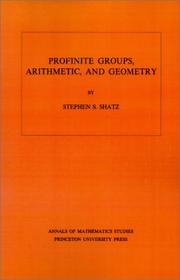
ISBN: 0691080178 1400881854 9780691080178 Year: 1972 Volume: 67 Publisher: Princeton : Princeton University Press,
Abstract | Keywords | Export | Availability | Bookmark
 Loading...
Loading...Choose an application
- Reference Manager
- EndNote
- RefWorks (Direct export to RefWorks)
In this volume, the author covers profinite groups and their cohomology, Galois cohomology, and local class field theory, and concludes with a treatment of duality. His objective is to present effectively that body of material upon which all modern research in Diophantine geometry and higher arithmetic is based, and to do so in a manner that emphasizes the many interesting lines of inquiry leading from these foundations.
Group theory --- Finite groups --- Algebraic number theory --- 512.73 --- 512.66 --- Homology theory --- Number theory --- Cohomology theory --- Contrahomology theory --- Algebraic topology --- Groups, Finite --- Modules (Algebra) --- Cohomology theory of algebraic varieties and schemes --- Homological algebra --- 512.66 Homological algebra --- 512.73 Cohomology theory of algebraic varieties and schemes --- Groupes, Théorie des. --- Group theory. --- Homology theory. --- Finite groups. --- Algebraic number theory. --- Abelian group. --- Alexander Grothendieck. --- Algebraic closure. --- Algebraic extension. --- Algebraic geometry. --- Algebraic number field. --- Brauer group. --- Category of abelian groups. --- Category of sets. --- Characterization (mathematics). --- Class field theory. --- Cohomological dimension. --- Cohomology. --- Cokernel. --- Commutative diagram. --- Composition series. --- Computation. --- Connected component (graph theory). --- Coset. --- Cup product. --- Dedekind domain. --- Degeneracy (mathematics). --- Diagram (category theory). --- Dimension (vector space). --- Diophantine geometry. --- Discrete group. --- Equivalence of categories. --- Exact sequence. --- Existential quantification. --- Explicit formula. --- Exponential function. --- Family of sets. --- Field extension. --- Finite group. --- Fundamental class. --- G-module. --- Galois cohomology. --- Galois extension. --- Galois group. --- Galois module. --- Galois theory. --- General topology. --- Geometry. --- Grothendieck topology. --- Group cohomology. --- Group extension. --- Group scheme. --- Hilbert symbol. --- Hopf algebra. --- Ideal (ring theory). --- Inequality (mathematics). --- Injective sheaf. --- Inner automorphism. --- Inverse limit. --- Kummer theory. --- Lie algebra. --- Linear independence. --- Local field. --- Mathematical induction. --- Mathematician. --- Mathematics. --- Module (mathematics). --- Morphism. --- Natural topology. --- Neighbourhood (mathematics). --- Normal extension. --- Normal subgroup. --- Number theory. --- P-adic number. --- P-group. --- Polynomial. --- Pontryagin duality. --- Power series. --- Prime number. --- Principal ideal. --- Profinite group. --- Quadratic reciprocity. --- Quotient group. --- Ring of integers. --- Sheaf (mathematics). --- Special case. --- Subcategory. --- Subgroup. --- Supernatural number. --- Sylow theorems. --- Tangent space. --- Theorem. --- Topological group. --- Topological property. --- Topological ring. --- Topological space. --- Topology. --- Torsion group. --- Torsion subgroup. --- Transcendence degree. --- Triviality (mathematics). --- Unique factorization domain. --- Variable (mathematics). --- Vector space. --- Groupes, Théorie des --- Nombres, Théorie des
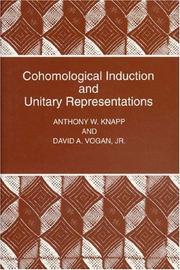
ISBN: 0691037566 1400883938 Year: 1995 Publisher: Princeton (N.J.): Princeton university press
Abstract | Keywords | Export | Availability | Bookmark
 Loading...
Loading...Choose an application
- Reference Manager
- EndNote
- RefWorks (Direct export to RefWorks)
This book offers a systematic treatment--the first in book form--of the development and use of cohomological induction to construct unitary representations. George Mackey introduced induction in 1950 as a real analysis construction for passing from a unitary representation of a closed subgroup of a locally compact group to a unitary representation of the whole group. Later a parallel construction using complex analysis and its associated co-homology theories grew up as a result of work by Borel, Weil, Harish-Chandra, Bott, Langlands, Kostant, and Schmid. Cohomological induction, introduced by Zuckerman, is an algebraic analog that is technically more manageable than the complex-analysis construction and leads to a large repertory of irreducible unitary representations of reductive Lie groups. The book, which is accessible to students beyond the first year of graduate school, will interest mathematicians and physicists who want to learn about and take advantage of the algebraic side of the representation theory of Lie groups. Cohomological Induction and Unitary Representations develops the necessary background in representation theory and includes an introductory chapter of motivation, a thorough treatment of the "translation principle," and four appendices on algebra and analysis.
512.73 --- Harmonic analysis --- Homology theory --- Representations of groups --- Semisimple Lie groups --- Semi-simple Lie groups --- Lie groups --- Group representation (Mathematics) --- Groups, Representation theory of --- Group theory --- Cohomology theory --- Contrahomology theory --- Algebraic topology --- Analysis (Mathematics) --- Functions, Potential --- Potential functions --- Banach algebras --- Calculus --- Mathematical analysis --- Mathematics --- Bessel functions --- Fourier series --- Harmonic functions --- Time-series analysis --- Cohomology theory of algebraic varieties and schemes --- 512.73 Cohomology theory of algebraic varieties and schemes --- Lie algebras. --- Lie, Algèbres de. --- Semisimple Lie groups. --- Representations of groups. --- Homology theory. --- Harmonic analysis. --- Représentations d'algèbres de Lie --- Representations of Lie algebras --- Abelian category. --- Additive identity. --- Adjoint representation. --- Algebra homomorphism. --- Associative algebra. --- Associative property. --- Automorphic form. --- Automorphism. --- Banach space. --- Basis (linear algebra). --- Bilinear form. --- Cartan pair. --- Cartan subalgebra. --- Cartan subgroup. --- Cayley transform. --- Character theory. --- Classification theorem. --- Cohomology. --- Commutative property. --- Complexification (Lie group). --- Composition series. --- Conjugacy class. --- Conjugate transpose. --- Diagram (category theory). --- Dimension (vector space). --- Dirac delta function. --- Discrete series representation. --- Dolbeault cohomology. --- Eigenvalues and eigenvectors. --- Explicit formulae (L-function). --- Fubini's theorem. --- Functor. --- Gregg Zuckerman. --- Grothendieck group. --- Grothendieck spectral sequence. --- Haar measure. --- Hecke algebra. --- Hermite polynomials. --- Hermitian matrix. --- Hilbert space. --- Hilbert's basis theorem. --- Holomorphic function. --- Hopf algebra. --- Identity component. --- Induced representation. --- Infinitesimal character. --- Inner product space. --- Invariant subspace. --- Invariant theory. --- Inverse limit. --- Irreducible representation. --- Isomorphism class. --- Langlands classification. --- Langlands decomposition. --- Lexicographical order. --- Lie algebra. --- Linear extension. --- Linear independence. --- Mathematical induction. --- Matrix group. --- Module (mathematics). --- Monomial. --- Noetherian. --- Orthogonal transformation. --- Parabolic induction. --- Penrose transform. --- Projection (linear algebra). --- Reductive group. --- Representation theory. --- Semidirect product. --- Semisimple Lie algebra. --- Sesquilinear form. --- Sheaf cohomology. --- Skew-symmetric matrix. --- Special case. --- Spectral sequence. --- Stein manifold. --- Sub"ient. --- Subalgebra. --- Subcategory. --- Subgroup. --- Submanifold. --- Summation. --- Symmetric algebra. --- Symmetric space. --- Symmetrization. --- Tensor product. --- Theorem. --- Uniqueness theorem. --- Unitary group. --- Unitary operator. --- Unitary representation. --- Upper and lower bounds. --- Verma module. --- Weight (representation theory). --- Weyl character formula. --- Weyl group. --- Weyl's theorem. --- Zorn's lemma. --- Zuckerman functor.
| Listing 1 - 9 of 9 |
Sort by
|

 Search
Search Feedback
Feedback About
About Help
Help News
News